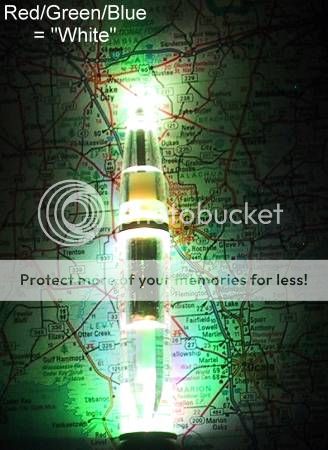[ QUOTE ]
UnknownVT said:
Are there any gaps in the spectrum when using white and amber LEDs?
[/ QUOTE ]
No more so than just using whites by themselves. In fact, the yellow phosphor used in most white LEDs peaks around 550 nm. Amber LEDs peak around 590 nm, so the amber simply bumps up the portion of the spectrum in the region from around 575 to 605 nm. It doesn't create gaps, but by the same token it doesn't fill in any, either. By using red instead of yellow you can both lower the color temperature and add output in an area of the spectrum where many white LEDs are somewhat deficient. The drawback to using any color other than amber for this is that you end up noticeably far off the Planckian locus. However, if my goal is to imitate certain types of fluorescent tubes then this is actually desireable.
[ QUOTE ]
I've noticed that the newer florescent replacement light bulbs/coils/folded tubes seem to bias a lot toward yellow - to the point some of my fluorescent bulb replacements seem more yellow than even the regular soft white tungsten light bulbs - anyone know if there is a good reason for this?
[/ QUOTE ]
None other than trying to imitate the much lower color temperature chandelier bulbs rather than halogens or standard incandescents. I believe the line of thinking here is that since these are drop-in incandescent replacements, then the designers believe that the end user prefers that type of light (or else they would already be using fluorescents). I've already had many discussions here regarding color temperature and individual preferences. Suffice it to say it's more a matter of taste than anything else. I tend to diagree that the majority would prefer 2700K once shown a range of choices. Some research tends to suggest the majority would be happiest right around 3500K to 5000K, depending upon lighting levels (higher lighting levels seem more natural at higher color temperatures and vice versa). My own preference is right around 5000K regardless of lighting levels, but I can readily adapt to anything from 3500K to 6500K. Above or below that I experience headaches and see poorly.
[ QUOTE ]
Aside - I have a fluorescent replacement bulb that's a cool white and although it does put out a lot of light -
I don't seem to see as well when compared to the more yellow fluorescents, and/or regular tungsten light bulbs of similar output ratings.
Similarly I have also noticed I seem to see better at similar output levels with a warmer white than cooler white LED, and using dim LEDs I see better with yellow/amber, than a white (other than color rendition)
Comments, suggestions?
[/ QUOTE ]
As for the first part, you need to compare tubes with similar color rendering before coming to a conclusion. CFLs usually tend to have a CRI of around 82. Cheaper cool whites around 62. If a tube has a better CRI you'll see better under it regardless of color temp. Most studies suggest the opposite of your experiences-things tend to be crisper under higher color temperatures. However, these studies don't take into account that many people's brains have in effect learned to see better under incandescent. This could be why warm white fluorescents and amber LEDs work better for you. I really wish I had a better answer for you than that. I've compared my modified bike light (20 white LEDs) to the stock halogen of about the same output. It easily appears about twice as bright, and colors seem more natural (closer to sunlight) to boot. This is in spite of the poorer CRI of white LEDs. And I just love my 5000K T-8 tubes with a CRI of 91. These provide great seeing, and come quite close to sunlight.


